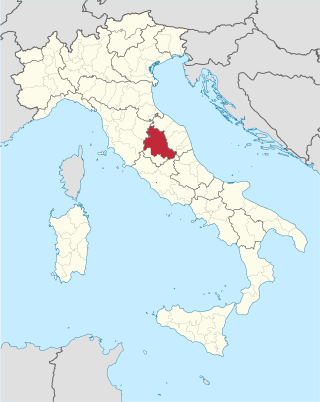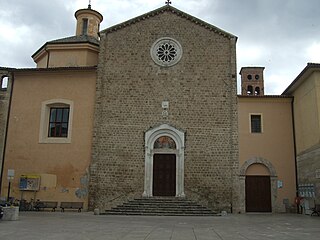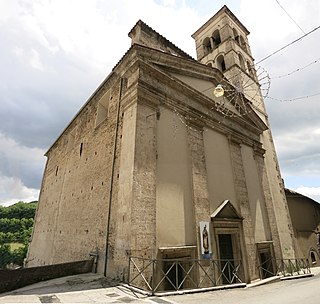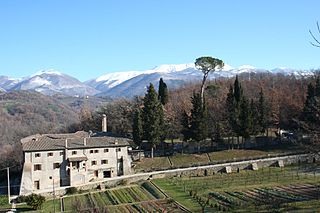Related Research Articles

Giovanni di Pietro di Bernardone, OFM, better known as Francis of Assisi, was an Italian mystic and Catholic friar who founded the Franciscans. He was inspired to lead a life of poverty as an itinerant preacher. One of the most venerated figures in Christianity, Francis was canonized by Pope Gregory IX on 16 July 1228. He is usually depicted in a brown habit with a rope around his waist with three knots, symbolizing the three Franciscan vows of poverty, chastity, and obedience.
Assisi is a town and comune of Italy in the Province of Perugia in the Umbria region, on the western flank of Monte Subasio.

The Province of Perugia is the larger of the two provinces in the Umbria region of Italy, comprising two-thirds of both the area and population of the region. Its capital is the city of Perugia. The province covered all of Umbria until 1927, when the province of Terni was carved out of its southern third. The province of Perugia has an area of 6,334 km² covering two-thirds of Umbria, and a total population of about 660,000. There are 59 comunes in the province. The province has numerous tourist attractions, especially artistic and historical ones, and is home to the Lake Trasimeno, the largest lake of Central Italy. It is historically the ancestral origin of the Umbri, while later it was a Roman province and then part of the Papal States until the late 19th century.

Greccio is an old hilltown and comune of the province of Rieti in the Italian region of Lazio, overhanging the Rieti valley on a spur of the Monti Sabini, a sub-range of the Apennines, about 16 kilometres by road northwest of Rieti, the nearest large town.

The Province of Rieti is a province in the Lazio region of Italy. Its capital is the city of Rieti. Established in 1927, it has an area of 2,750.52 square kilometres (1,061.98 sq mi) with a total population of 157,887 people as of 2017. There are 73 comuni in the province.

Brother Leo was the favorite disciple, secretary and confessor of St Francis of Assisi. The dates of his birth and of his becoming a Franciscan are not known; a native of Assisi, he was one of the small group of most trusted companions of the saint during his last years.

La Verna is a locality on Mount Penna, an isolated mountain of 1,283 metres (4,209 ft) situated in the centre of the Tuscan Apennines, rising above the valley of the Casentino, central Italy. The place is known especially for its association with Saint Francis of Assisi and for the Sanctuary of La Verna, which grew up in his honour. Administratively it falls within the Tuscan province of Arezzo and the comune of Chiusi della Verna, Italy.

Poggio Bustone is a comune (municipality) in the Province of Rieti in the Italian region of Latium, located about 70 kilometres northeast of Rome and about 11 kilometres (7 mi) north of Rieti.
Rivodutri is a comune (municipality) in the Province of Rieti in the Italian region of Lazio, located about 70 kilometres (43 mi) northeast of Rome and about 13 kilometres (8 mi) north of Rieti.

The Sanctuary of Arcella, popularly known as Sant'Antonino, is a Roman Catholic church located in the neighborhood of Arcella, just north of the city of Padua, region of Veneto, Italy. The sanctuary preserves the room in which St Anthony of Padua died on June 13, 1231. Today it also serves as a parish church, ministered by monks of the Franciscan order.

The Hermitage of Greccio Sanctuary is one of the four shrines erected by St. Francis in the Sacred Valley, along with the Sanctuary of Fonte Colombo, the Sanctuary of the Forest, and the convent of Poggio Bustone. It is located in the Italian town of Greccio, about 15 kilometres (9.3 mi) from the city of Rieti, seat of the homonym province, is recessed at an altitude of 665 metres (2,182 ft) above sea level, in the rocks of the mountains in the immediate vicinity of the medieval village of Greccio with views of the wide Rieti Valley.
The Sanctuary of St. Gabriel of Our Lady of Sorrows is located at the foot of the Gran Sasso, in the municipality of Isola del Gran Sasso, in Teramo province, Abruzzo region, Italy. The shrine receives an average of 2 million visitors a year and is thus one of the 15 most visited sanctuaries in the world.

The Rieti Valley or Rieti Plain is a small plain in central Italy, where lies the city of Rieti, Lazio. It is also known as Sacred Valley and Holy Valley since saint Francis of Assisi lived here for many years and erected four shrines, which have become the destination of pilgrims.
The Sanctuary of Santa Maria delle Grazie is a Roman Catholic church and Franciscan convent located in the frazione of Ponticelli within the town limits of Scandriglia, province of Rieti, region of Lazio, Italy. It is presently still a Franciscan monastery, with support of the Fondo Edifici di Culto of the Interior Ministry.

San Francesco is a Gothic-style, deconsecrated Roman Catholic church located on Piazza San Francesco in the medieval center of the city of Rieti, region of Lazio, Italy.

Santa Chiara is a former Roman Catholic church and convent in the city of Rieti, province of Rieti, region of Lazio, Italy.

Santa Lucia is a Baroque-style, former-Roman Catholic church and the adjacent convent is located on Vicolo Santa Lucia #8 in the medieval center of the city of Rieti, region of Lazio, Italy. The church now mainly celebrates Roman Orthodox rites. The convent in 2020 houses the archaeologic collections of the Museo Civici of Rieti.

The Sanctuary of Santa Maria della Foresta, abbreviated as the Santuario della Foresta is one of a local cluster of four sanctuary-monasteries, originally based on rural oratories founded in the Rieti Valley by Francis of Assisi in the areas near Rieti, Lazio, Italy. This sanctuary is located about 3.5 km from Rieti, and near the town of Castelfranco.

Illuminatus of Arce or Illuminatus of Rieti was an earlier follower of Francis of Assisi.
Illuminato da Chieti, in Latin Illuminatus de Theate, was a Franciscan friar who served as the bishop of Assisi from 1274 until his death.
References
- ↑ The other Franciscan sanctuaries of the Rieti Valley are Santuario di Greccio, Santuario della Foresta, and Santuario di Poggio Bustone.
- ↑ Umbria e Lazio, guidebook, page 102.